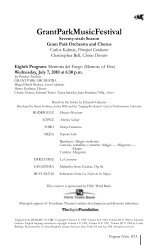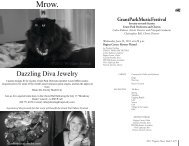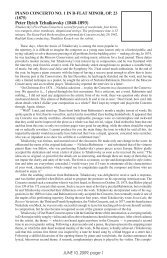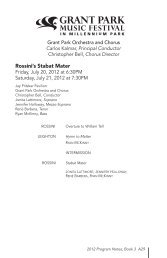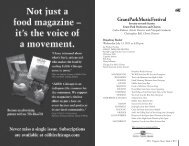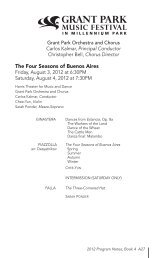cute Brahms Bizet.pdf - The Grant Park Music Festival
cute Brahms Bizet.pdf - The Grant Park Music Festival
cute Brahms Bizet.pdf - The Grant Park Music Festival
You also want an ePaper? Increase the reach of your titles
YUMPU automatically turns print PDFs into web optimized ePapers that Google loves.
Wednesday, August 18, 2010<br />
GRANT PARK MUSIC FESTIVAL<br />
teacher whose own First Symphony had appeared only a year earlier), and vitalized it with his own<br />
ebullient, youthful spirit and characteristic touches of melody, harmony and orchestration. Curiously,<br />
the work seems not to have been performed during <strong>Bizet</strong>’s lifetime. <strong>The</strong> manuscript became<br />
part of his estate after his death and passed into the possession of his wife, who did not fully<br />
appreciate her husband’s genius. She bequeathed it to the composer Reynaldo Hahn, and he to<br />
the Paris Conservatoire Library, where it gathered dust until <strong>Bizet</strong>’s first English biographer, D.C.<br />
<strong>Park</strong>er, unearthed it in 1933. It was finally premiered on February 26, 1935 in Basle, Switzerland<br />
by Felix Weingartner.<br />
<strong>The</strong> Symphony in C opens with a movement in traditional sonata form, with a bubbling main<br />
theme outlining chordal patterns and a contrasting legato second theme, introduced by the oboe,<br />
in longer notes. <strong>The</strong> slow second movement contains a haunting, bittersweet serenade for oboe<br />
followed by a soaring melody for strings. <strong>The</strong> movement is rounded out by the return of the oboe<br />
theme. <strong>The</strong> concluding two movements are a sprightly scherzo with a rustic-sounding trio, and a<br />
vivacious finale, cast, like the first movement, in sonata form.<br />
PIANO CONCERTO NO. 1 IN D MINOR, OP. 15 (1854-1859)<br />
Johannes <strong>Brahms</strong> (1833-1897)<br />
<strong>Brahms</strong>’ Piano Concerto No. 1 is scored for woodwinds and trumpets in pairs, four<br />
horns, timpani and strings. <strong>The</strong> performance time is approximately 44 minutes. <strong>The</strong><br />
<strong>Grant</strong> <strong>Park</strong> Orchestra first performed this Concerto on July 29, 1959. <strong>The</strong>odore<br />
Bloomfield conducted, and Gary Graffman was the soloist.<br />
<strong>Brahms</strong>, in his philosophy and his attitude toward music, was the first<br />
modern composer. He emerged as a creator around 1850, at just the time when the signs of interest<br />
in the centuries-long history of music first became evident. During earlier generations, a composer<br />
developed his style based almost exclusively on knowledge of only his own and the immediately<br />
preceding generations, choosing either to continue composing around the same aesthetic principles<br />
or to change them in subtle or drastic ways. At no time before the 19th century was the music of<br />
earlier eras emulated, venerated or, in most cases, even known. <strong>The</strong> exceptions are few: notably, the<br />
oratorios of Handel, the contrapuntal church style of Palestrina and the Well-Tempered Clavier of<br />
Bach, and even the last two of these were more familiar from pedagogy than from performance.<br />
<strong>Brahms</strong>, unlike those before him, drew from the entire history of German music — from Lassus<br />
to Bach to Beethoven — and, in so doing, was the first composer to face that set of imposing questions<br />
for the creative artist about the historical flow of musical tradition: “What do I keep?” “What<br />
do I discard?” “Where do I fit in?”<br />
<strong>The</strong> 19th century was a time of many noteworthy explorations into the past. Schliemann unearthed<br />
Troy; Champollion broke the code of the Rosetta Stone; and a determined French scholar<br />
named Coussemaker brushed away seven centuries of dust and forgetfulness to expose the earliest<br />
music of western civilization. <strong>Brahms</strong> saw himself not only as the beneficiary of this newly discovered<br />
treasure from earlier times, but also as its curator, a responsibility he accepted as a scholar<br />
as well as a composer: he was on the advisory board of the first complete edition of the works of<br />
Bach. In his compositions, <strong>Brahms</strong> forged a distinctive style from three of the great traditions of<br />
German music — the lush and luxuriant textures of Lassus and Bach, the formal techniques of<br />
Beethoven and the emotionally expressive harmony of Schumann. <strong>Brahms</strong> brought to this amalgam<br />
his own wonderful lyricism and sense of musical architecture.<br />
<strong>Brahms</strong> did battle with the problem of creating something new without defacing the tradition<br />
he revered in every work he wrote. Nowhere is the struggle more evident, however, than in the First<br />
Symphony and this First Piano Concerto. He labored for five years on the Concerto before it was<br />
performed, and then went back and revised it some more. His original intention was to produce a<br />
symphony in D minor as his first major orchestral work, and, to that end, he sketched three movements<br />
in short score in 1854. <strong>The</strong> first movement was orchestrated, but <strong>Brahms</strong> was not satisfied<br />
with the result, and he decided to transform his short score into a sonata for two pianos. But even<br />
this did not fulfill his vision, as he noted in a letter to Joseph Joachim, violinist, conductor and<br />
Program Notes D27



